Day 2 of our big 5 day Spring Bird Tour. It was meant to rain today, at least in the afternoon, but although it was cloudy all day and it did drizzle a little on and off at times, it was not as bad as forecast. It was a day back in North Norfolk today.
Given the forecast of rain, we decided to spend at least part of the day at Titchwell, where we could take shelter in the hides. On the way there, we took a short detour up to Choseley. In a ploughed field by the road, a number of Wheatears were running around. W counted at least seven of them, including several smart males with their black bandit masks. There were also good numbers of Brown Hares in the fields, although they were mostly hunkered down. A strikingly pale Common Buzzard perched briefly on the ground a couple of fields away before flying and disappearing behind a hedge.
 Wheatear – a smart male in the ploughed field
Wheatear – a smart male in the ploughed field
As soon as we got out of the car in the car park at Titchwell, we could hear a Turtle Dove. The delicate purring song of the male is now an increasingly rare sound, which is a real shame, so it was great to listen to it. It seemed to be coming from deep in a very leafy sycamore at first, where we couldn’t see it. Then, more helpfully, it took off and did a short display flight, flapping up quickly, then gliding down and dropping towards the overflow car park.
We walked round to the other side and shortly after we arrived, the Turtle Dove flew up again and glided down into the top of a dead tree. We managed to get a quick look at it there, through the scope, before it flew again, back to the main car park. We thought it might have gone back to the sycamore but instead it had landed on a dead branch out in full view. This time, we all got a good view of it in the scope. Then it flew off again towards visitor centre. We were heading that way, so we followed on behind.
 Turtle Dove – displaying in the car parks at Titchwell this morning
Turtle Dove – displaying in the car parks at Titchwell this morning
As we walked towards the visitor centre, we could hear a Goldcrest singing in the trees beyond the picnic area. There is a small path which goes in to the trees here, so we walked in to see if we could find it. There was no sign of the Goldcrest but one of the group did spot a cracking pink male Bullfinch high in the oak trees, feeding on buds. The browner female was nearby, and we could hear the two of them calling to each other quietly. They were in the trees above the access road and the two of them flew off calling as a car came along, though thankfully not before we had all had a good look at them.
The feeders by the visitor centre were quiet today, apart from a single Jackdaw swinging on the peanuts. So we headed straight out onto the reserve. It has been very high spring tides for the last few days, so the pool on the Thornham grazing marsh, which should be full of freshwater but has been allowed to dry out for the last couple of years, had been flooded with saltwater. The landowner (this is not part of the reserve) has been in dispute with everyone seemingly for the last few years and appears to have done this out of spite, even though he is in breach of his stewardship conditions. Unfortunately Natural England seem to show no inclination to pursue him, so in the meantime this site is being damaged with salt water.
At least, with a few pools on there today, a single Little Ringed Plover was enjoying it. Even through it was towards the back, we could see the golden yellow eye ring through the scope. Two or three Marsh Harriers were quartering over the reeds, and a smart male made a nice fly past for us. The warblers were a little subdued today, in the cold and windy weather, apart from a Sedge Warbler which was singing and display flighting constantly. A couple of Reed Warblers sang rather half-heartedly from deep in the reeds. A Cetti’s Warbler shouted at us occasionally too.
The reedbed pool was quiet today, but while we had stopped to scan the reeds, one of the reserve volunteers very kindly came back to tell us that some Bearded Tits were showing from the main path a little further along. We hurried over and had great views as the pair worked their way around the base of the reeds at the back of the small pools below the path. They were a pair – a smart male, with powder blue head and black moustache, following behind a browner female.
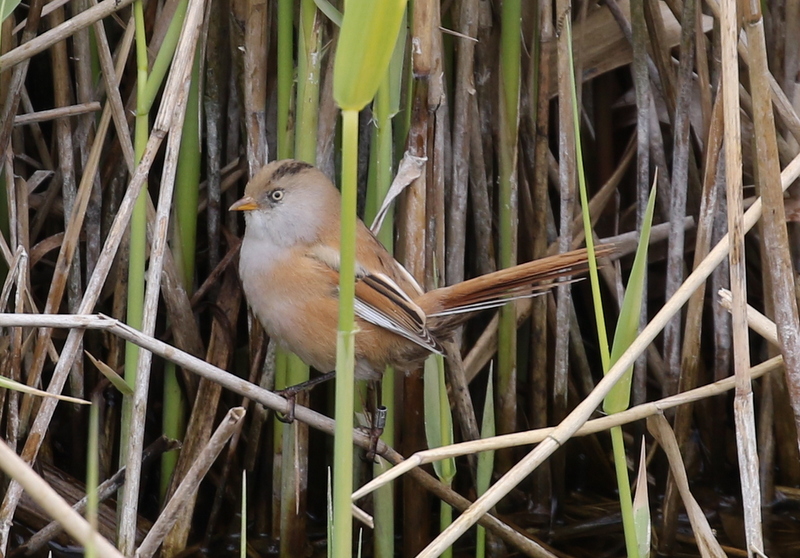 Bearded Tit – the female, by the pools below the main path
Bearded Tit – the female, by the pools below the main path
This was a real bonus today – Bearded Tits can be very hard to see on cold windy days normally! Eventually they flew up over the brambles behind the pools and disappeared into the main reedbed. While we were standing there, we could also see at least four drake Red-crested Pochard in one of the channels.
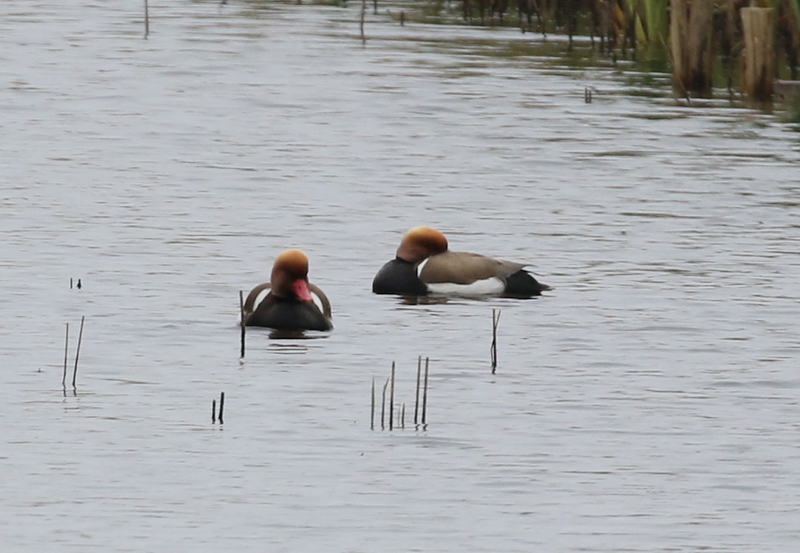 Red-crested Pochard – 2 of the 4 drakes we could see in the reedbed channel
Red-crested Pochard – 2 of the 4 drakes we could see in the reedbed channel
It started to drizzle at this point so we decided to head for the shelter of Island Hide. The water level on the Freshmarsh is still very high, which means there are not many waders on here at the moment. There were several pairs of Avocets, but those that were trying to feed on here were up to their bellies in water. There were a few Black-headed Gulls roosting on one of the shallower patches and several Ruff were running around amongst them. There was one larger male, though not yet sporting its summer ruff, and several smaller female Reeves.
 Avocet – up to its belly in the deep water
Avocet – up to its belly in the deep water
The water on here is more to the liking of the ducks, but numbers have dropped now as many have headed off on their their way north already. There were still a few Gadwall and Shoveler, plus a few lingering Teal and a lone pair of Wigeon in fenced off ‘Avocet Island’. The number of Brent Geese is also dropping now, but a pair flew past the hide and one was still out on the water, though most of them were feeding out on the saltmarsh.
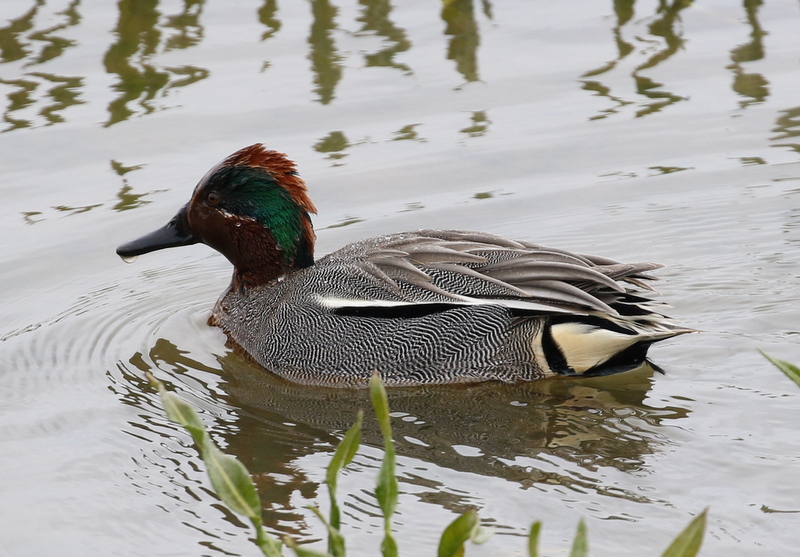 Teal – the number of remaining winter wildfowl has dropped now
Teal – the number of remaining winter wildfowl has dropped now
There were more gulls on the Freshmarsh than anything else at the moment. The Black-headed Gulls have taken a liking to the fenced off ‘Avocet Island’ and a sizeable gull colony is forming on there. Black-headed Gulls actually have chocolate brown heads in summer, but in with them we could see a good number of darker black heads. There were around 20 Mediterranean Gulls which have joined the colony here and through the scope we could see their heavier and brighter red bills and pure white wing tips. They are very smart looking birds.
A small group of immature Herring Gulls were standing in the water just outside the fence. One of them instantly stood out – it was very white headed, with a long face and a long bill. It was a 2nd calendar year (also known as 1st summer) Caspian Gull. When it climbed up onto a submerged rock we could see it had rather long thin legs too.
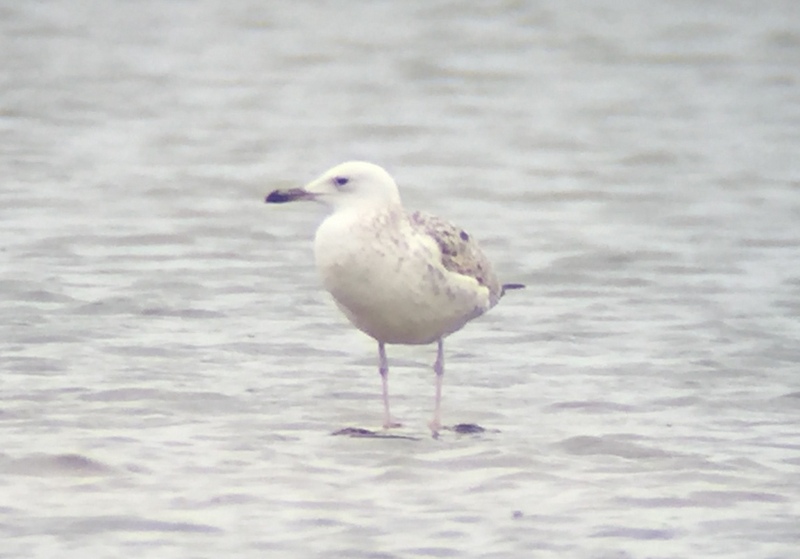 Caspian Gull – a 1st summer bird, a bit of a rarity at Titchwell
Caspian Gull – a 1st summer bird, a bit of a rarity at Titchwell
Caspian Gulls were originally to be found breeding north of the Black Sea and further east, but they have spread north and west in recent years and now also breed in Poland and eastern Germany. They have also been turning up more regularly here as a consequence. They are still a bit of a rarity, particularly at Titchwell, so we sent a message back to some of the birders at the visitor centre. Pretty soon a small crowd arrived in the hide and there was a flurry of activity as everyone got onto the bird. We all watched it for a while, before eventually it took off, circled round, and disappeared over the bank out towards the beach.
The rain had stopped now and it appeared to be brightening up, so we made a dash for the beach. The Volunteer Marsh was quiet. Around the channel at the far end, we found a few Black-tailed Godwits, two Grey Plover, one grey and one black-bellied, and a single Knot still in grey winter plumage. There was not much to see on the Tidal Pools either today, but it had been a big high tide this morning and everything was still looking a bit wet.
There were lots more birds out at the beach. Out on the sea, we could see several flocks of black dots. A couple of groups closer in included around 20 Velvet Scoter – we got a good look at these through the scope, the white in the wing being visible when they flapped and on some swimming birds too. A vast slick of up to 2,000 Common Scoter were smeared across the water further out. A single young drake Eider was swimming close inshore in the breakers but a long way away to the east, towards Brancaster.
There were lots of gulls out on the beach, feeding on the debris washed up by the strong north winds of the last couple of days. The resident Black-headed Gull followed us around for a while, but it wasn’t time for lunch yet. Around the mussel beds by the shore, we could see a variety of waders, so we walked down for a closer look. There were several little groups of Sanderlings together with a few Turnstones running around on the beach. Several Bar-tailed Godwits and a few more Knot were down on the mussel beds.
 Black-headed Gull – hoping for some food from the birders at the beach
Black-headed Gull – hoping for some food from the birders at the beach
It was pretty cool out out on the beach, in the wind. After a quick look at the waders, we headed back. It was time for lunch when we got to the visitor centre and a warm drink was most welcome too. After lunch, we drove a short distance west to Thornham.
There have been a few Whimbrel reported on the playing fields at Thornham recently, but it has mostly been early morning, probably before they get too disturbed. Despite it being the middle of the day and with lots of cars coming and going from the car park, we found four Whimbrel still out on the short grass. They were mostly at the back, where we could get a good view of their striped heads through the scope, although two did fly in and land much closer to use, in the middle of the cricket pitch at one point.
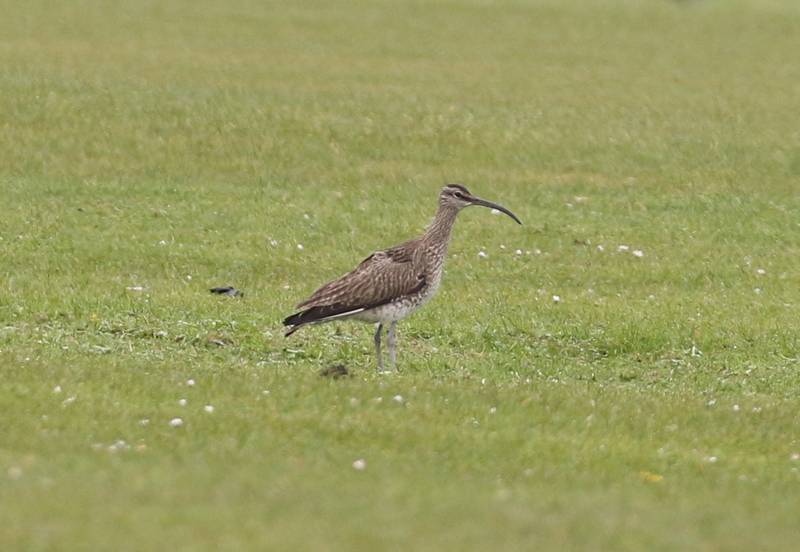 Whimbrel – four were on the playing field at Thornham this lunchtime
Whimbrel – four were on the playing field at Thornham this lunchtime
Whimbrel is just a passage migrant here, so it was great to see some birds which had stopped off on their way north. We had a quick look down at Thornham Harbour, as we were in the vicinity. Another couple of Whimbrel flew across the road as we drove down – presumably this is one of the places they come to when they are disturbed from the playing fields. One landed right next to the car, and started feeding on the saltmarsh, which gave us a great chance to look at it up close.
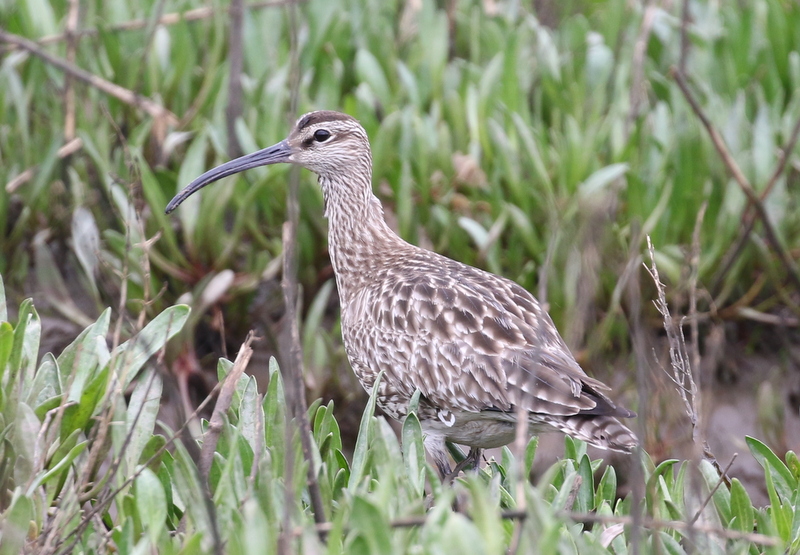 Whimbrel – another two were down by the harbour
Whimbrel – another two were down by the harbour
Otherwise, it was fairly quiet here with the tide out. A Little Egret flew off from the channel as we approached and we could see a distant Grey Plover out on the mud. We decided not to stop, so turned around and set off back east along the coast road. We called in briefly at Brancaster Staithe on the way, but it was very busy, lots of cars and boats in the car park, and very few birds.
We were heading for Holkham for the rest of the afternoon. When we got out of the car at Lady Anne’s Drive, we could see several Egyptian Geese and Greylags on the grazing marshes. A Common Buzzard was perched on a post on the bank preening. A female Grey Partridge was tucked down in the grass and a Mistle Thrush flew over and up into the pines.
Rather than head out to the beach, we took the path west on the inland side of the pines. Two Blackcaps were singing in the trees, right next door to each other, but both were tucked well in and neither would show themselves. A Goldcrest was flicking around in the pines overhead. We flushed a couple of Jays as we walked along, flying away with a flash of a white rump, but one perched up nicely by the side of the path for us briefly. A Chiffchaff singing in the trees was more obliging, and we got a good look at it as it flitted between the branches of a bare elm.
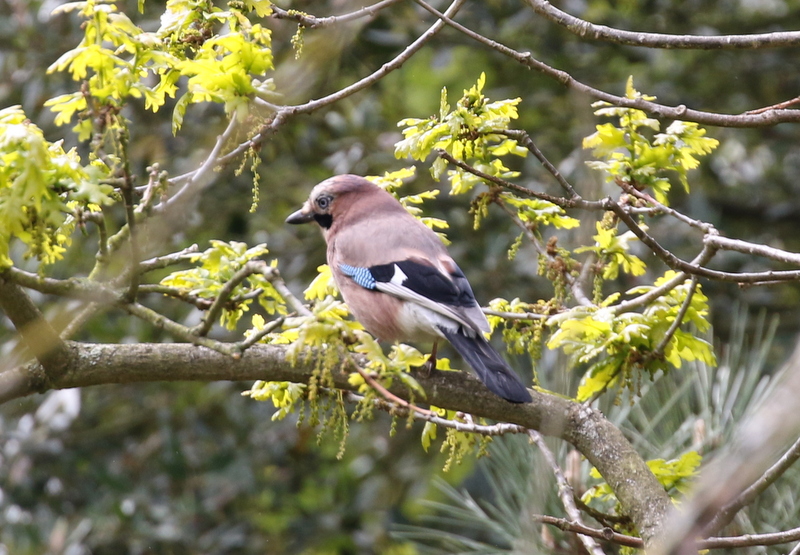 Jay – this one perched up nicely for us briefly
Jay – this one perched up nicely for us briefly
We could hear a couple of Sedge Warblers singing noisily from the reeds by Washington Hide. From the raised vantage point of the boardwalk to the hide, we had a quick scan of the marshes. A late pair of Pintail on one of the pools were a nice addition to the trip list.
As we continued west along the path, past Meals House, we stopped several times to look out at the grass. We were rewarded with a small group of four Pink-footed Geese. There are always a small number here right through the summer, when all the vast hordes of them have long since departed for Iceland, mostly injured birds which can’t make the journey north. One of the Pinkfeet had obviously been shot and winged, holding its wing at a jaunty angle. A pair of Barnacle Geese had presumably just come over from the feral flock in Holkham Park. Two more drake Pintail were upending on the pools beyond.
As we approached the Joe Jordan Hide we could hear a Willow Warbler singing from the trees out on the freshmarsh. From up in the hide, we could see Spoonbills coming and going from the trees constantly. Most were flying in and out and landing out of view, but occasionally, one would perch up on the edge of the trees, where we could get it in the scope. 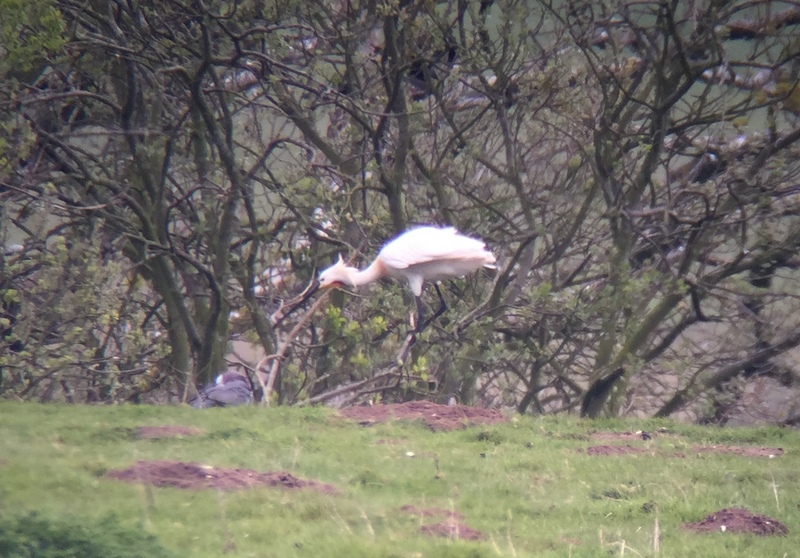 Spoonbill – one would occasionally perch up in the trees where we could see it
Spoonbill – one would occasionally perch up in the trees where we could see it
There was not much activity down on the pool today until later on, when a couple of Spoonbills came down to bathe and preen and one came down to collect nest material, giving us another chance of a better look at them. Most were breeding adults, with yellow tipped blackbills, a shaggy crest on the back of the head and a dirty yellow wash across the breast.
We hadn’t seen it down in the reeds, but suddenly a Great White Egret flew up from the back of the pool, and disappeared behind the trees. It was just a brief flight view, but its enormous size was immediately apparent, flying with long rounded wings and slow deep wingbeats. A little while later, what was possibly the same flew Great White Egret flew out of the trees and landed down in a ditch the other side.
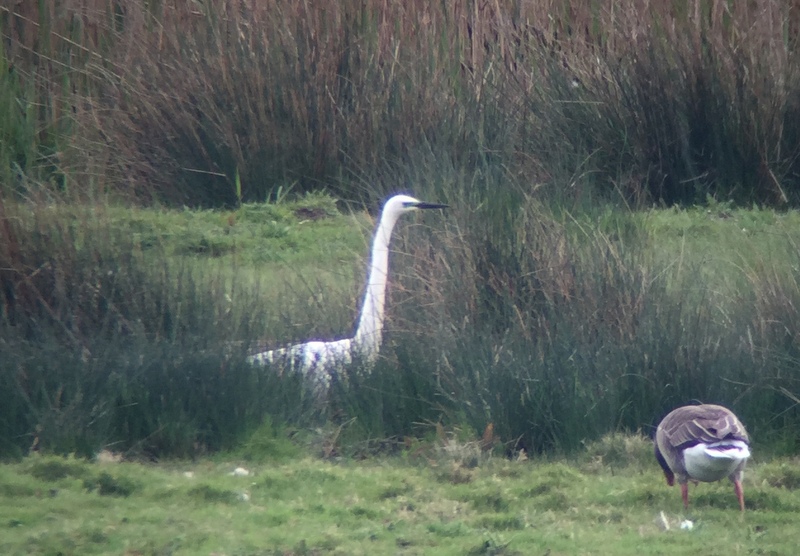 Great White Egret – we saw two from the hide at Holkham today
Great White Egret – we saw two from the hide at Holkham today
While we were watching that, a second Great White Egret flew over, buzzed the first, and dropped in nearby. The two of them seemed to feed happily for a short while, a reasonable distance apart, until one decided to chase off the other. The first flew back to the trees, while the second circled back and landed again, before resuming feeding in the ditch.
There were lots of other things to see while we sat in the hide. A steady succession of Marsh Harriers kept coming and going. A Common Swift was flying back and forth over the trees. A Chinese Water Deer walked along the edge of the ditch below us. It is a lovely spot here to sit and watch all the activity. But eventually we had to tear ourselves away and head for home. Back at the car, a couple of Spoonbills did a flypast over Lady Anne’s Drive, heading back to the colony, bidding us farewell.
















